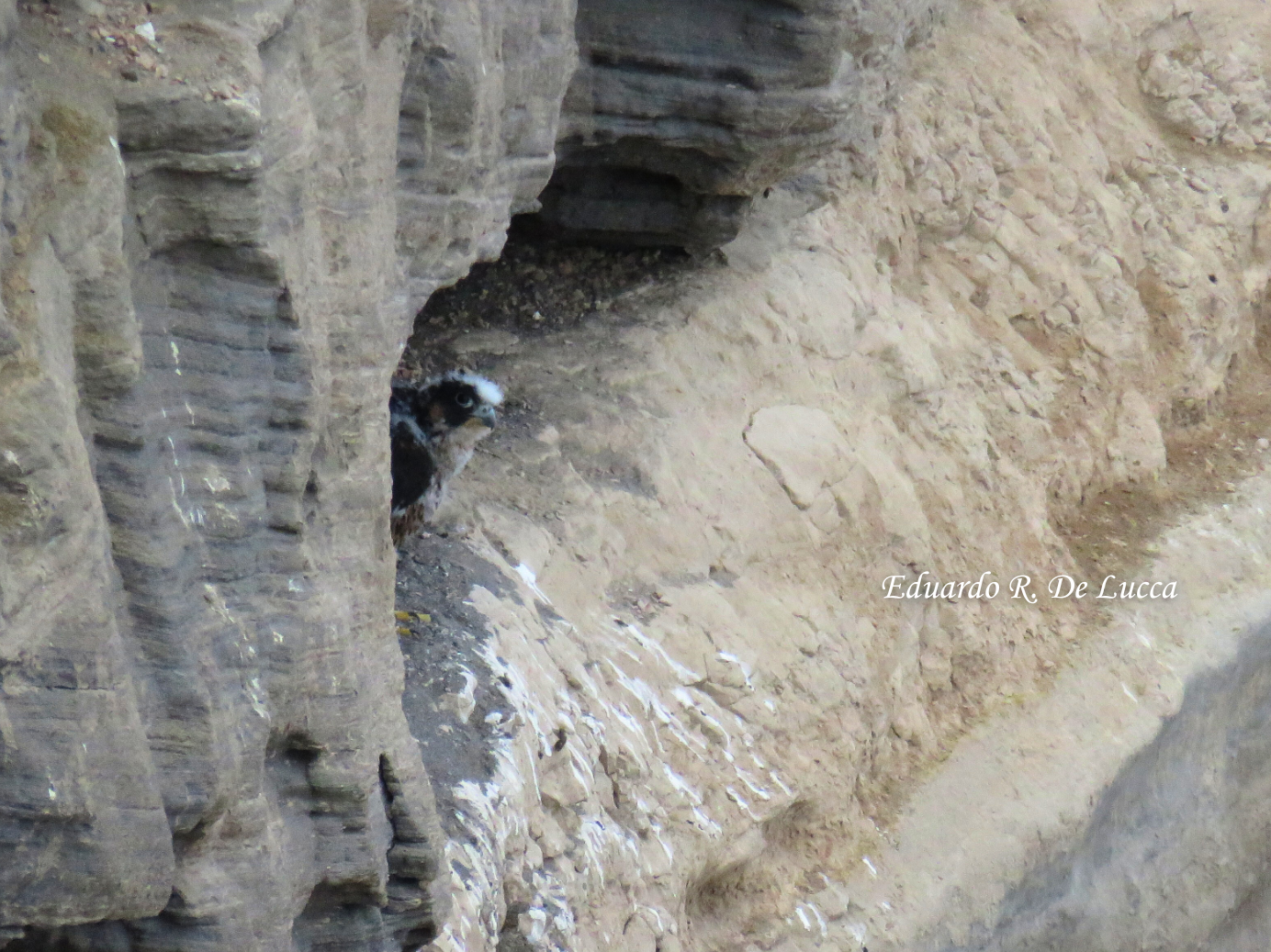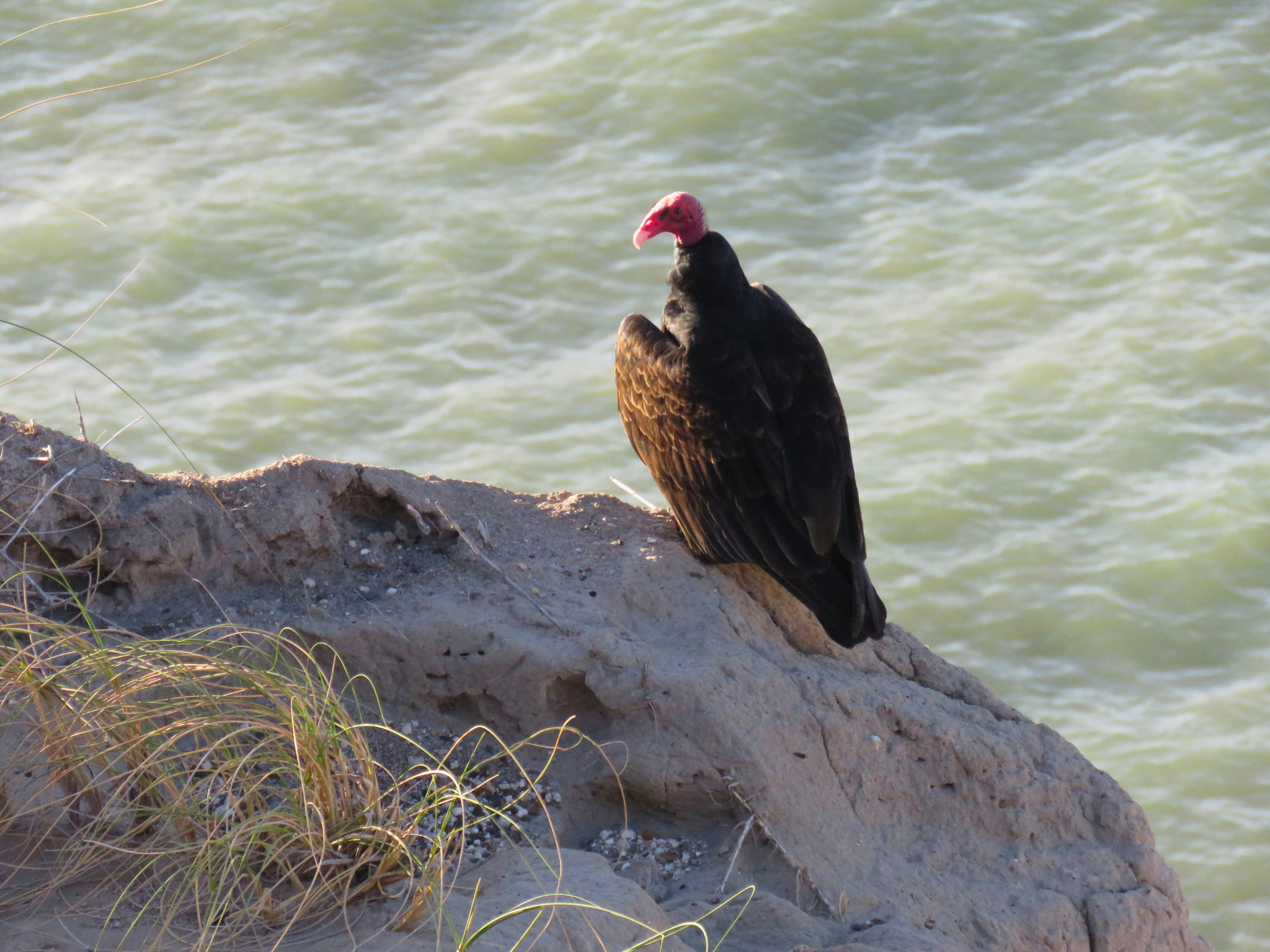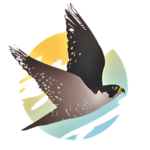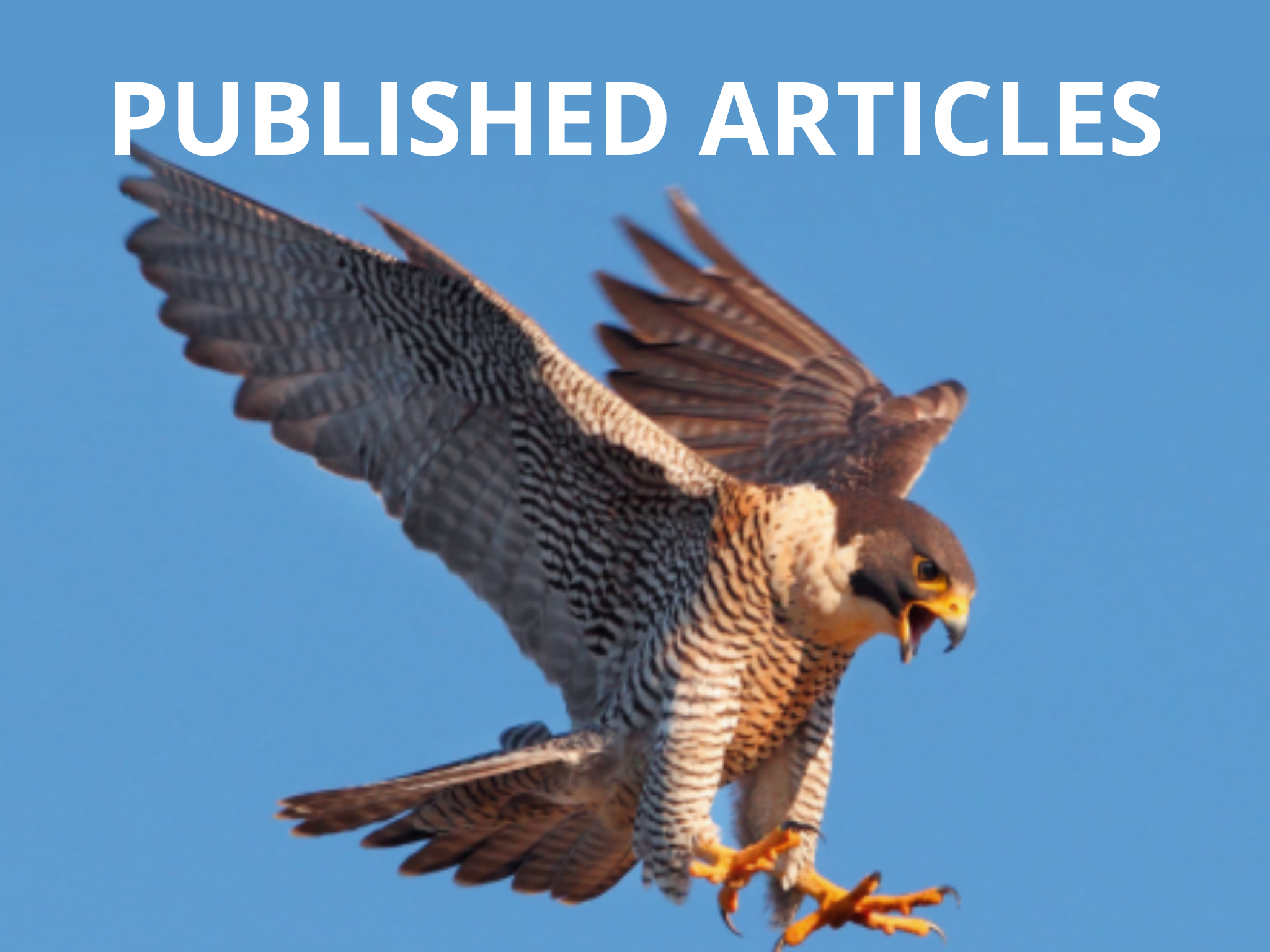Summary
𝗦𝗼𝘂𝘁𝗵 𝗔𝗺𝗲𝗿𝗶𝗰𝗮𝗻 𝗣𝗲𝗿𝗲𝗴𝗿𝗶𝗻𝗲 𝗙𝗮𝗹𝗰𝗼𝗻 (𝙁𝙖𝙡𝙘𝙤 𝙥𝙚𝙧𝙚𝙜𝙧𝙞𝙣𝙪𝙨 𝙘𝙖𝙨𝙨𝙞𝙣𝙞)
In 2010, a population with a high density of breeding pairs was discovered on cliffs of the Argentine Sea. This population has been surveyed over 11 breeding seasons. During eight of these seasons, through intensive monitoring, data was collected about density, distance between nests, and reproductive parameters (average number of chicks per successful pair and total number of chicks produced by the population). Interannual variations were observed in both density and reproductive parameters, especially starting in 2020 when this population became one with the highest density of pairs of the world. Currently, information from approximately 90 breeding attempts is available.
For the first time for this subspecies of peregrine falcon, daily activity, the role of sexes in parental care, and chick behavior were studied.
Furthermore, the northernmost nesting site of a mixed pair, consisting of a pale morph female and a "normal" male, was described (in Chubut province).

𝗔𝗺𝗲𝗿𝗶𝗰𝗮𝗻 𝗞𝗲𝘀𝘁𝗿𝗲𝗹 (𝙁𝙖𝙡𝙘𝙤 𝙨𝙥𝙖𝙧𝙫𝙚𝙧𝙞𝙪𝙨)
In 2015, the first studies of this falcon breeding along sea coasts were made. This is to highlight, considering it is the most abundant raptor in the Americas. A high density of breeding pairs was detected reproducing on the cliffs that stretch between the Río Negro Lighthouse and the visitor center of the "Punta Bermeja" National Park (1 territorial pair every 1.25 km), with a nesting success rate of 55-60%.
Furthermore, the mentioned study included descriptions of nesting sites, distances between nests, and the first nest of the species located outside a cavity. In 2022, monitoring was conducted, which revealed that this population continues to maintain its numbers.

𝗔𝗽𝗹𝗼𝗺𝗮𝗱𝗼 𝗙𝗮𝗹𝗰𝗼𝗻 (𝙁𝙖𝙡𝙘𝙤 𝙛𝙚𝙢𝙤𝙧𝙖𝙡𝙞𝙨)
In 2011, a nest of this falcon was found on an electrical transmission pole in Río Negro, and years later, another one was discovered on a similar structure during a return trip to Buenos Aires (located in the Patagones district, bordering the Patagonia region). Apart from these records, there would be no other data of nesting on human-made structures for this subspecies. F. f .femoralis.

𝗖𝗵𝗶𝗺𝗮𝗻𝗴𝗼 𝗖𝗮𝗿𝗮𝗰𝗮𝗿𝗮 (𝙈𝙞𝙡𝙫𝙖𝙜𝙤 𝙘𝙝𝙞𝙢𝙖𝙣𝙜𝙤)
We made known the first population of the species nesting on marine coasts, with the particularity that it is the only case, described up to now, of a falconid that builds a nest of sticks/branches within cavities (tunnels). The fact that numerous pairs choose nests built by burrowing parrots (𝘊𝘺𝘢𝘯𝘰𝘭𝘪𝘴𝘦𝘶𝘴 𝘱𝘢𝘵𝘢𝘨𝘰𝘯𝘶𝘴) as substrate makes this phenomenon even more interesting and peculiar. Detailed studies conducted during the breeding seasons of 2014 and 2015 provided data on pair density, characteristics of nesting sites, and interaction with the psittacids. Counts carried out over several years have allowed an estimation of the abundance of pairs in a sector of about 30 km within the study area.
Furthermore, reproductive associations of Chimango Caracaras have been described not only with burrowing parrots but also with pairs of cinereous harriers (𝘊𝘪𝘳𝘤𝘶𝘴 𝘤𝘪𝘯𝘦𝘳𝘦𝘶𝘴), black vultures (𝘊𝘰𝘳𝘢𝘨𝘺𝘱𝘴 𝘢𝘵𝘳𝘢𝘵𝘶𝘴), and turkey vultures (𝘊𝘢𝘵𝘩𝘢𝘳𝘵𝘦𝘴 𝘢𝘶𝘳𝘢) (in the "Bahía San Antonio" Natural Protected Area). They have also been found nesting in proximity to american kestrels, peregrine falcons, and long-winged harriers (𝘊𝘪𝘳𝘤𝘶𝘴 𝘣𝘶𝘧𝘧𝘰𝘯𝘪).

𝗦𝗼𝘂𝘁𝗵𝗲𝗿𝗻 𝗖𝗮𝗿𝗮𝗰𝗮𝗿𝗮 (𝘾𝙖𝙧𝙖𝙘𝙖𝙧𝙖 𝙥𝙡𝙖𝙣𝙘𝙪𝙨)
In 2014, two nests of this falcon species were found on electrical transmission poles. Prior to this discovery, there was only one known instance of nesting in human structures. What is striking is the scarcity of this species along the maritime coast of the Golfo San Matías.
𝗩𝗮𝗿𝗶𝗮𝗯𝗹𝗲 𝗛𝗮𝘄𝗸 (𝙂𝙚𝙧𝙖𝙣𝙤𝙖𝙚𝙩𝙪𝙨 𝙥𝙤𝙡𝙮𝙤𝙨𝙤𝙢𝙖)
In 2011, the largest known breeding population of this raptor in the world was discovered (nesting on electrical poles). In 2014, a detailed study was conducted on this population, observing high densities as well as variations in the linear density of pairs across different sectors of the surveyed area. Additionally, data on the breeding performance of 30 pairs were obtained during that season.
From 2010 to 2019, a monitoring of breeding pairs was conducted within the boundaries of the "Punta Bermeja" Natural Protected Area, providing, for the first time, valuable information about their reproduction on seaside coasts.
A "collateral" contribution has been the description, for the first time with concrete data, of the nesting of this raptor in the province of Buenos Aires (nests detected during trips to the study area).

𝗕𝗹𝗮𝗰𝗸-𝗰𝗵𝗲𝘀𝘁𝗲𝗱 𝗕𝘂𝘇𝘇𝗮𝗿𝗱-𝗘𝗮𝗴𝗹𝗲 (𝙂𝙚𝙧𝙖𝙣𝙤𝙖𝙚𝙩𝙪𝙨 𝙢𝙚𝙡𝙖𝙣𝙤𝙡𝙚𝙪𝙘𝙪𝙨)
In 2010, three nests of this eagle were found located on coastal cliffs, one of which was within the "Pozo Salado" Natural Protected Area. The descriptions of these nests would be the first concrete records of nesting in the Argentine Sea. In 2011, these sites were surveyed again, and all three pairs seem to found to be active.

𝗖𝗶𝗻𝗲𝗿𝗲𝗼𝘂𝘀 𝗛𝗮𝗿𝗿𝗶𝗲𝗿 (𝘾𝙞𝙧𝙘𝙪𝙨 𝙘𝙞𝙣𝙚𝙧𝙚𝙪𝙨)
In 2011, a breeding group was discovered in the "Bahía San Antonio" Natural Protected Area, associated, as previously mentioned, with chimango caracaras and two species of vultures. The interesting aspect of this loose-colony is that it would be the first one settled on coastal dunes, with nests located directly on the ground. The few previously described nesting groups were detected in wetlands, with nests supported by vegetation and above the water level. This is to take into acount when expanding the range of habitats in which to search for such breeding groups. Monitoring of this site was carried out in subsequent years, and during the initial years, an increase in the number of pairs was recorded. However, in recent years, this breeding group has experienced a decline in its numbers.

𝗟𝗼𝗻𝗴-𝘄𝗶𝗻𝗴𝗲𝗱 𝗛𝗮𝗿𝗿𝗶𝗲𝗿 (𝘾𝙞𝙧𝙘𝙪𝙨 𝙗𝙪𝙛𝙛𝙤𝙣𝙞)
In 2013, on the banks of the Río Negro, 10 km from its mouth in the Argentine Sea, a breeding group of this species was found. This nesting record stands as the southernmost for the species on a global scale. Associated with the discovered nests were pairs of chimango caracaras with nests located in bushes and also on the ground.

𝗥𝗲𝗱-𝗵𝗲𝗮𝗱𝗲𝗱 𝗩𝘂𝗹𝘁𝘂𝗿𝗲 (𝘾𝙖𝙩𝙝𝙖𝙧𝙩𝙚𝙨 𝙖𝙪𝙧𝙖) 𝗮𝗻𝗱 𝗕𝗹𝗮𝗰𝗸 𝗩𝘂𝗹𝘁𝘂𝗿𝗲 (𝘾𝙤𝙧𝙖𝙜𝙮𝙥𝙨 𝙖𝙩𝙧𝙖𝙩𝙪𝙨)
Nests of these species were occasionally found during focused surveys for other species. In 2022, an article was published containing information about several nesting sites located along the Golfo San Matías, highlighting nesting associations between both species and with chimango caracaras and Cinereous Harriers (as previously mentioned). This publication also describes the associated nesting of the black vulture with seabirds in the newly created "Islote Lobos" National Park. This nesting record represents the most southeastern breeding record of the species on a global scale. Also of interest is the finding of a nest of a black vulture pair in an abandoned nest of a burrowing parrot.



